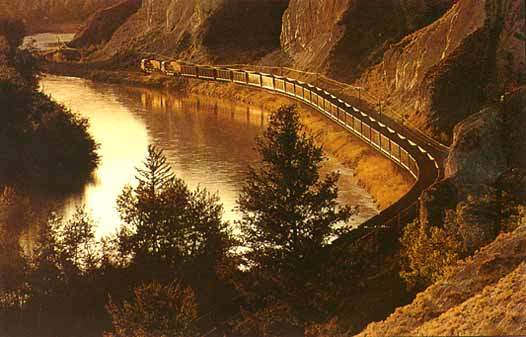Designed as a 3Mt/y operation, Fording River began production in 1971 and made its first shipment of metallurgical coal in April 1972. Formerly Fording Coal Ltd’s largest metallurgical/thermal coal mine, its primary product is high-quality metallurgical coal used to produce coke for the international steel industry. The mine also produces and sells thermal coal for use by power utilities and associated industries.
In 2003, ownership of Coal Mountain was transferred to the Elk Valley Coal Partnership, now 60% owned by Fording Canadian Coal Trust and 40% by the major Canadian mining company, Teck Cominco.
Elk Valley Coal is the world’s second-largest supplier of metallurgical coal, with sales of 22.6Mt in 2006. Fording River itself now has a mine capacity of 8.9Mt/y and a wash plant capacity of 10Mt/y, but in 2006 produced only 7.7Mt. This was considerably lower than the 9.2Mt produced in 2005 and 9.5Mt in 2004 and reflected the strongly competitive world market for hard coking coal in 2006.
Located 30km from Elkford in south-eastern British Columbia, Fording River produces Canada’s widest range of bituminous coals from a single site. A detailed mine plan spanning more than 20 years has been developed that focuses on consolidating the majority of the truck/shovel fleet in one area: Eagle Mountain.
This vast coal reserve provides Fording River with large, integrated mining areas capable of supporting economies of scale, efficient waste hauls and an improving strip ratio over the life of the mine plan.
The decision to develop the Eagle Mountain resource came in 1981. Initial development, including access and infrastructure, commenced in 1982 with the first coal produced in 1984. The detailed mine plan has been complemented by a long-term reclamation programme for Eagle Mountain.
Geology
Coal resources in the Elk River district are hosted in rocks of the Jurassic Kootenay formation. The strata have been extensively folded and faulted, a factor that has helped increase the apparent thickness of seams in some areas. The coals are generally low- to medium-volatile bituminous in rank and, despite their often high in-situ ash content, the region’s coking coals are favoured for their blending characteristics.
As of end-2006, Fording River’s proven and probable reserves totalled 227Mt of clean coal in 20 different seams, plus a further 660Mt in measured and indicated resources. Over 65% of this is currently contained in the Eagle Mountain deposit, containing around 15 seams ranging in thickness from 1m to 15m. Additional reserves outside the planned mining areas will support mining and expansion at Fording River for more than 25 years.
The low-sulphur seams grade from medium to high volatile, the volatile contents increasing upwards in the stratigraphic section. This gradation provides a range of coal seams that contain Fording River’s three distinct coking coal product types.
Open-pit mining
Fording River uses both dragline and shovel-and-truck operations to strip overburden. In areas other than Eagle Mountain, overburden is drilled and blasted then dragline stripped to expose the underlying coal seam. The dragline is then used to pile the coal for subsequent loading into 155t-capacity hauliers for transport to the crusher.
At Eagle Mountain, mining shovels load blasted overburden into 218t- and 290t-capacity haul trucks for disposal. A bench height of 15m is used. Dozers then clean the coal seam surface, pushing the exposed coal down to the bench floor, where it is loaded into trucks for haulage to the crusher.
The mine uses four P&H 4100 and 2800 mining shovels equipped 55m³, 44m³ and 23m³ buckets, and three 44m³ Marion 301-M and 351-M shovels, loading a fleet of Komatsu 830E and 930E, and Caterpillar 793C trucks with over- and inter-burden.
There is also a Hitachi EX3500 hydraulic mining excavator, while run-of-mine coal is loaded by three LeTourneau wheel loaders and is moved by a fleet of Wabco hauliers.
The mine manages its product requirements to meet customer needs by allocating equipment to the appropriate stratigraphic horizons within the pits.
Coal processing
Fording River’s coal preparation plant is among the most efficient in the world, handling more than 27,000t/d of products in 2000. After crushing and screening, the coal is washed using dense-medium cyclones, spirals and flotation then dried to remove excess moisture for shipping. The dryer uses coal as its primary source of fuel.
The plant’s existing capacity of 9.5Mt/yr is being increased to 10.5Mt/yr by mid-2005, in response to increased demand from Elk Valley Coal’s customers in the Far East.
Clean products are stockpiled before loading into unit trains for transport to the Westshore Terminals export facility at Roberts Bank, south of Vancouver. After loading, each rail wagon is sprayed with latex to prevent coal dust emissions during the journey.
Coal qualities
Typical Fording River product qualities are:
| Mid-volatile PCI coal |
High-volatile coking coal |
|
| Ash (%) | 9.0-11.0 | 6.0 |
| Volatile matter (%) | 22.0-24.0 | 26.7-29.4 |
| Sulphur (%) | 0.6-0.7 | 0.6-0.65 |
| Heating value (MJ/kg) | 29.3-33.5 | 32.4 |






